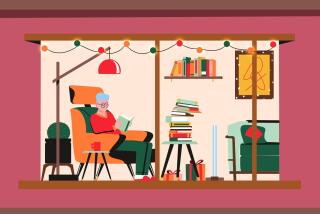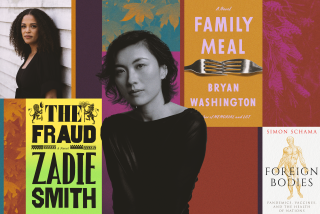In touch with Strachey
- Share via
London — IF the cellphone had been invented in Lytton Strachey’s time, he would’ve had it plastered to his ear. One can just imagine the highly social writer, a hard-core member of the famous Bloomsbury circle and author of the landmark 1918 biography “Eminent Victorians,” ringing up his tight circle of friends and family to relay his dishy opinions of the people and plays he had just seen. But Strachey had to make do with writing letters, and he wrote thousands of them, including many to Leonard Woolf, his Cambridge classmate, and Virginia Woolf, whom he adored and even once proposed to, though he was homosexual. (Fortunately for both, she declined.)
For Paul Levy, editor of the recently published “The Letters of Lytton Strachey,” wading through the abundance of material was both an enormous task and a fateful duty to literary history.
Though he now lives in an Oxfordshire cottage that was once part of the historic Blenheim Palace estate, Levy was born and raised in Kentucky and limned this colorful youth in his 1986 autobiography “Finger-Lickin’ Good: A Kentucky Childhood.” His path to Anglicization and entree to the British cultural elite -- he is an executor of the Strachey literary estate -- sounds like destiny. “It was just being every place at the right time,” Levy says. “The connections were amazing.”
*
Making connections
GOING through the cafeteria at the Tate Britain museum, Levy, 65, eyes the salad but picks up a sausage and ale instead. He’s a burly man with thinning curls of reddish hair and an ever healthy appetite. In addition to being a Bloomsbury scholar, he wears another hat as food and wine expert, and yet another as arts reviewer. Recent health problems have made walking difficult for him, but he gets to exhibitions and plays and commutes regularly from his country home into the city for work.
After nearly four decades in Britain, he speaks with a distinctly English accent, with all the cadences of the “U” (or university) class. He has a habit of repeating a word or short phrase as if stuttering; he says, “No, no, no-O-O-O-oo ... “ with the last “no” elongated and dipping in the end.
Levy came to Britain in the 1960s to read philosophy at University College, London, and returned in 1968 to work on a book on Cambridge philosopher G.E. Moore. “I never meant to stay,” he says, but he wound up as a resident of the British Isles.
Easing his way in those early London years were two couples who “adopted” him and brought him into their circle. One of them was Lord and Lady David Cecil, parents of one of his best friends from his doctoral program at Harvard, “introduced me to everybody,” he says, “Iris Murdoch and John Bayley, for example.” Through his other friends -- “my Communist friends,” he laughs -- he met Hollywood writers who had been exiled by McCarthyism, including Donald Ogden Stewart (“The Philadelphia Story”).
The connections were not only social, they also helped his work. “G.E. Moore’s widow Dorothy had lots of suitors for her husband’s papers,” Levy says. “She did give them to me. One of the reasons was that Rachel Cecil was G.E. Moore’s goddaughter -- another connection.”
A man he shared a flat with turned out to be an “Apostle,” a member of a secret society at Cambridge to which Strachey had belonged. This contact eventually led to Levy’s being able to see some of their membership documents.
*
Reading Strachey
IN 1968 Levy met Lytton Strachey biographer Michael Holroyd. Holroyd introduced him to Alix Strachey, the widow of Lytton’s brother James, who held many of the writer’s personal papers. In 1972, she established a foundation to oversee those papers, and Holroyd and Levy were named the initial trustees. Levy put together some of the material in an early book, “Lytton Strachey: The Really Interesting Question.”
Levy also found himself increasingly fascinated by food during the nouvelle cuisine revolution. He started writing book reviews in the mid-’70s, and Ann Barr at Harpers & Queen magazine asked him to review some cookbooks, then to become a regular contributor.
With a sense of British self-deprecation, he recalls how piles of letters would come in complaining about him. “Too many truffles or too few truffles, depending on your point of view,” he says. He went on to collaborate with Barr on the tongue-in-cheek 1984 classic, “The Official Foodie Handbook,” with such chapters as “Foodie for Thought,” and served as food and wine editor at the Observer. (He still writes a wine column for the Mail on Sunday.)
In 1999, Levy turned again to Strachey. Holroyd, after finishing an updated biography of the writer, decided to pass on photocopies of the letters he’d collected to Levy. They’d always meant to publish a more extensive volume of Strachey’s letters, and the photocopies saved Levy a lot of legwork.
“The original letters are all over the place,” he says. “Some are at the University of Texas, the New York Public Library, with most of them at the British Library.” Additional letters showed up through research and some were offered when people heard of his project.
Levy made a series of cuts to reduce the material to fit into one volume. “I chose on two grounds,” he says. “The first ground was literary merit, how well they were written. The second ground was what they contributed to the narrative that every book of letters has to tell.” (He’s also included his own notes to explain certain references.) He did not include every letter Strachey wrote to Dora Carrington, the one woman that he perhaps really did love, but has included every letter to Virginia Woolf.
“First there was a manageable number,” says Levy. “Secondly, they’re some of the best writing. Thirdly, they’ve never all been printed in an unexpurgated fashion before.” This is possible, he says, because most members of the Bloomsbury circle have died.
Strachey believed that one really gets to know a writer through his correspondence, and Levy notes that the insights gained can be “immensely moving and fulfilling even if you loathe him.” He refers to a review in the Boston Globe. “The reviewer thought he was one of her heroes, but then she read his letters and she decided she couldn’t stand him!” He laughs. Yes, Strachey was sponging off Lady Ottoline Morrell “while writing letters that were very rude about her hospitality,” Levy says. “That’s true, and I didn’t defend it.”
Strachey, from an upper-middle-class background, lived comfortably but was never rich. Still, as he described in his letters, he appreciated the finer things in life, like seeing the latest plays and performances and occasional vacations. He was, as Levy says, “the original champagne socialist.”
However, his letters tell much about his changing era. Strachey was strongly against World War I and sat it out as a conscientious objector. He was a proud homosexual when homosexuality was illegal. He saw through the hypocrisies of his society, evidenced by his none-too-reverent biographies in “Eminent Victorians.” “Is it prejudice, do you think, that makes us hate the Victorians, or is it the truth of the case?” he writes in a letter to Virginia Woolf. “They seem to me a set of mouthing bungling hypocrites.”
Perhaps, Levy suggests, we remain fascinated by the Bloomsbury circle because “they are so like our generation. We had Vietnam, they had the First World War. We had the ‘60s, gay lib, women’s lib; they had suffrage. They had a real intellectual struggle against the dark forces of religion; we have the same thing. They had colonialism, and we have the consequences of it. The most important thing is, they lived at the dawn of Modernism in the arts. They were there, they were creating it. Culturally, we’re still living on their work.”
More to Read
Sign up for our Book Club newsletter
Get the latest news, events and more from the Los Angeles Times Book Club, and help us get L.A. reading and talking.
You may occasionally receive promotional content from the Los Angeles Times.







